Bluebank Communication Technology VP5001I Smartphone User Manual
Bluebank Communication Technology Co.Ltd. Smartphone
Contents
- 1. User manual
- 2. User Manual
User manual

VP5001I
Guía de referencia rápida

Índice
Características del equipo ........................................ 3
Antes de empezar .................................................... 5
Encendido/Apagado del teléfono ...........................5
Para encender el teléfono ..................................5
Para apagar el teléfono ......................................5
Desbloqueo de la pantalla ......................................5
Bloqueo de la pantalla ............................................7
Utilizando la pantalla táctil .....................................7
Barra de estado ......................................................8
Orientación de la pantalla.....................................10
Teclas y funciones .................................................10
Aplicaciones (Apps) y herramientas (Widgets) .....10
Conexión a Internet mediante una WLAN .............. 12
Conexión a Internet mediante banda ancha móvil . 13
Por su seguridad .................................................... 14
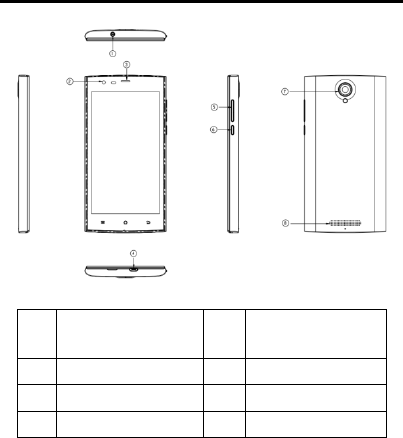
Características del equipo
①
Conexión para
auriculares MiniJack
de 3,5 mm
②
Cámara frontal
③
Auricular
④
Micro USB 2.0 HS
⑤
Botón de volumen
⑥
Botón de encendido
⑦
Cámara trasera
⑧
Altavoz

Instalación de la tarjeta SIM y tarjeta SD
Instalación de la batería
Fijación de la tapa trasera

Antes de empezar
Encendido/Apagado del teléfono
Para encender el teléfono
1. Pulse y mantenga presionado el botón de encendido
momentáneamente.
2. Deslizando su dedo, desbloquee la pantalla.
Para apagar el teléfono
1. Pulse y mantenga presionado el botón de encendido y seleccione la
opción Apagar.
2. Seleccione OK y el teléfono se apagará después de algunos segundos.
Desbloqueo de la pantalla
Cuando encienda su teléfono encontrará que su teléfono está bloqueado
por defecto. Para desbloquear la pantalla:
1. Presione el botón de encendido para que la pantalla muestre la
imagen.
2. Para desbloquear la pantalla, arrastre el anillo con un candado en su
interior, hasta el borde del círculo (derecha). De estar bloqueado con
un patrón de dibujo, dibuje el patrón ya establecido. De estar
bloqueado con un PIN o clave secreta, introduzca el que
corresponda.

Bloqueo de la pantalla
Para bloquear la pantalla, presione el botón de encendido. También podrá
configurar el teléfono para que se bloquee automáticamente después de
un período de inactividad determinado.
Seleccionar → Configuración (o Ajustes) → Pantalla → Suspender esta
opción le permitirá configurar el tiempo de suspensión después de 15 o 30
segundos, 1, 2, 5, 10 o 30 minutos.
Utilizando la pantalla táctil
Excepto el encendido/apagado y volumen, todas las funciones del teléfono
se llevan a cabo mediante la pantalla táctil. Por lo tanto, es fundamental
saber cómo se utiliza dicha pantalla táctil.
Los siguientes movimientos con los dedos le permitirán entender con
facilidad cómo se utiliza la pantalla táctil.
Seleccionar: para ejecutar, ingresar a un menú u opción de
cualquier aplicación o herramienta que aparezca en la pantalla,
selecciónelo con su dedo.
Doble Clic: con su dedo, seleccione el ítem dos veces.
Arrastrar: con su dedo, seleccione y mantenga presionado el ítem
deseado y desplácelo sin dejar de hacer contacto con la pantalla.
Cambiar de pantallas: con su dedo, seleccione cualquier espacio
abierto en la pantalla y deslizando su dedo vertical u
horizontalmente podrá pasar de una pantalla a otra.
Pellizcar: para ampliar una pantalla coloque dos dedos sobre la
pantalla y sepárelos; para disminuir una pantalla coloque dos
dedos sobre la pantalla y únalos. Esta función también se puede
utilizar en páginas electrónicas y varios tipos de archivos.
Pulsar y seleccionar: seleccione un ítem que aparezca en la lista de
opciones disponibles.

Pulsar y mantener: durante unos segundos, seleccione cualquier
ítem hasta que aparezca un listado de opciones.
Precaución:
No utilice objetos afilados que puedan rallar la pantalla.
No permita que la pantalla haga contacto o limpie la misma con
productos químicos ya que dichos productos pueden dañar la
pantalla.
Para evitar daños a la pantalla del equipo, evite sentarse sobre el
teléfono.
Barra de estado
La barra de estado se encuentra en el borde superior de la pantalla la cual
muestra notificaciones de diversas aplicaciones, la hora y el estado en que
se encuentran varias opciones, tales como la carga de la batería, la señal
WLAN, la señal del equipo y otros más.
1. Los iconos del panel de notificación le brinda información acerca de
correo electrónico, mensajes y de otras funciones. Para visualizar
esta información deslice la barra superior hacia abajo y seleccione el
icono deseado que a su vez le permitirá visualizar la información.

2. La barra de estado muestra el estado en qué se encuentra el teléfono
y sus dispositivos, tales como la batería, su carga, alarmas, Bluetooth
así como otras funciones. Al deslizar esta barra hacia abajo se tendrá
acceso a más opciones de ajustes y configuración.

Orientación de la pantalla
Para obtener una visualización óptima de la pantalla, la orientación de la
misma cambiará automáticamente dependiendo de la forma en que se
sostenga el teléfono.
NOTA: para activar o desactivar la auto-rotación, deslice el panel de estado
y seleccione el icono de auto-rotación.
Teclas y funciones
1. Tecla “Volver”
Para volver a la pantalla previa o salir de una aplicación, seleccione
la tecla “Volver”.
Para cerrar el teclado virtual también puede presionar la tecla
“Volver”.
2. Tecla “Inicio”
Para regresar a la pantalla principal seleccione la tecla “Inicio”.
Para abrir la opción de búsqueda en Google, presione y mantenga
la tecla “Inicio”.
3. Tecla “Menú”
Esta opción se utiliza para abrir aplicaciones usadas
recientemente.
Aplicaciones (Apps) y herramientas (Widgets)
Aplicaciones: consisten en programas que permiten llevar a cabo
funciones específicas. El teléfono cuenta una variedad de
aplicaciones precargadas y otras aplicaciones se pueden descargar
mediante la aplicación Google Play.
Herramientas: el teléfono también cuenta con una serie de
aplicaciones pequeñas alojadas en la pantalla principal las cuales
brindan información útil de manera fácil y rápida.
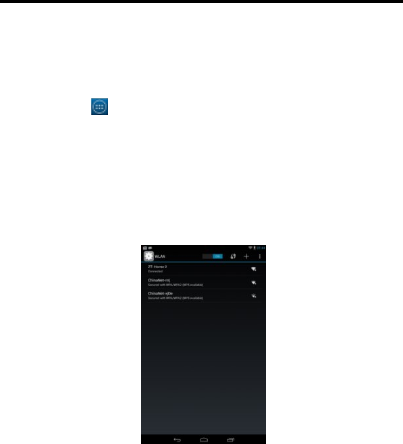
Conexión a Internet mediante una WLAN
NOTA: el alcance y calidad de la señal de la WLAN estará sujeta a la
distancia entre el teléfono y el router, el número de dispositivos
conectados al mismo, las instalaciones y objetos por donde se transmite la
señal.
1. Seleccione → Ajustes→ Redes Inalámbricas→ WLAN.
2. Active el WLAN deslizando el botón hacia la posición SI (ON) y el
teléfono detectará las redes WLAN dentro de su alcance.
3. Seleccione la red a la que desea conectarse.
4. Introduzca la clave secreta (en caso de conectarse a una red segura) y
luego seleccione “Establecer Conexión” lo que permitirá conectarse a
la red deseada.
NOTA: para conectarse a una red WLAN segura, se deberá introducir la
clave secreta. De no contar con la clave secreta, se deberá contactar al
administrador de la red WLAN o al fabricante del router.

NOTA: para buscar nuevas redes WLAN, en la pantalla donde aparecen las
WLAN, seleccione → Buscar
Conexión a Internet mediante banda ancha móvil
1. Seleccione Ajustes → Redes Inalámbricas→ WLAN, luego
seleccione WLAN para desactivar la función.
2. El teléfono buscará la señal correspondiente automáticamente y se
conectará a la red del operador. Mientras el teléfono esté conectado
a una red de banda ancha móvil, aparecerá un icono en la barra de
estado.
NOTA: En los modelos LTE/HSPA+, de estar ambas redes disponibles, el
teléfono, prevalecerá la conexión a la red WLAN.

Por su seguridad
A continuación aparecerá información de cómo mantener el teléfono y las
medidas de seguridad que se deben tomar.
Mantenga el equipo y sus accesorios fuera del alcance de mascotas.
No permita que niños jueguen con el teléfono y en caso de utilizarlo,
que lo hagan adecuadamente.
El teléfono debe permanecer en condiciones secas y en temperaturas
normales.
El teléfono no se debe almacenar en lugares polvorientos o sucios.
No trate de desarmar el teléfono.
No deje caer o someta el teléfono a fuertes impactos.
Para la limpieza del teléfono no se deben utilizar productos químicos,
disolventes ni detergentes.
Si su equipo deja de funcionar adecuadamente, póngase en contacto
inmediatamente con un servicio técnico.
Sólo se deben emplear baterías, cargadores y accesorios autorizados
por el fabricante. Cualquier avería producto de baterías, cargadores y
accesorios no autorizados por el fabricante anularán la garantía del
teléfono.
PRECAUCIÓN: No asumimos ninguna responsabilidad sobre el
incumplimiento de las directrices arriba descritas o por el uso inapropiado
del Smartphone. Nuestra empresa se reserva el derecho a realizar
modificaciones en cualquiera de los contenidos de este manual de usuario
sin aviso previo. El contenido de este manual puede variar respecto al
contenido real mostrado en el Smartphone. En cuyo caso, este último debe
imperar.

VP5001I
Quick Start Guide

Product Overview
①
Earphone 3.5mm Slot
②
Front-Camera
③
Receiver
④
Micro USB 2.0 HS
⑤
Volume Key
⑥
Power Key
⑦
Rear-Camera
⑧
Speaker
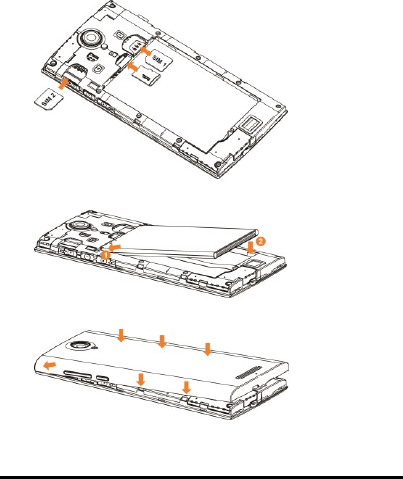
Assemble SIM Card & SD Card
Assemble the battery
Assemble the back cover
Getting Started
Turning the phone On/Off
To turn On the phone
1. Press and hold the PWR key for a few seconds.
2. Unlock the screen with your finger.
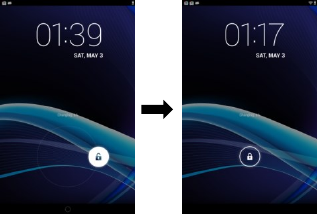
To turn Off the phone
1. Press and hold the PWR key, select Power Off.
2. Tap OK. The phone will be off in a few seconds.
Unlocking screen
The screen is locked by default when you turn on the phone. To
unlock the screen,
1. Press the PWR key.
2. Drag the inner ring to the edge of the circle to unlock the
screen. Draw a pattern if the screen is protected by pattern lock.
Enter a PIN or a password if the screen is locked by a PIN or a
password.
Locking screen
To lock the screen, press the PWR key. It is recommended to lock the
screen to protect information in the phone and reduce battery usage. You
can also configure your phone to automatically lock after a certain period
of time.
Tap → Settings → Display → Sleep to set the sleep time from 15
seconds, 30 seconds, 1 minute, 2 minutes, 5 minutes, 10 minutes, or 30
minutes.
Using touch screen
All of the functions of the phone, except for power and volume, are
performed on the touch screen. Therefore, it is essential to know how to
use the touch screen.
The following finger actions might help you easily understand how to
use the touch screen.
Tap: Touch an item (e.g. application or widget)
once that appears on the screen with your finger to run it or
access a menu or an option
Double tap: Tap an item twice with your finger
Drag: Tap and hold your finger on an item and
move it without losing contact with the screen
Flick: Place a finger on an empty space of the
screen and move the screen up or down, or left or right
Pinch: Place two fingers on the screen and
move them apart to zoom in a picture, a document or a web page,
or move them together to zoom out
Select and tap: Tap an item in the list of options
available
Press and hold: Press a key or any item for a
few seconds until a list of options appears
Cautions:
Do not use sharp tools that can scratch the
touch screen.
Do not allow the touch screen to come in
contact with chemicals. The screen may malfunction in chemicals.
Do not sit on the phone: the touch screen can

be damaged.
Status bar
The status bar at the top of the screen notifications from various
apps, time, and the states of various devices such as battery status, WLAN
status, Signal status and so on.
1. Notification panel displays notification icons to inform you of
new Email, messages, and so on. Slide the panel down to view the
notifications and then tap a notification icon to view details of the
notification.
2. Status panel displays status icons to show the current state
of your phone, such as battery charging progress, alarms, Bluetooth,
and so on. Slide the panel down to access more settings and
configuration options.

Screen orientation
For optimal viewing experience, the screen orientation changes
automatically depending on how you hold the phone.
NOTE: To enable or disable auto-rotate, slide down the status panel
and tap the Auto-rotate icon.
Keys and functions
1. Back key
Tap to return to the previous screen and exit
the running application.
Tap to close the on-screen keyboard in text
input mode.
2. Home key
Tap to return to the main screen.
Tap and hold to open the Google search.

3. Menu key
Tap to open the applications list used recently.
Apps and widgets
Apps: Software that allows you to perform a
specific task. Your phone is preloaded with a variety of
applications, and additional applications can be downloaded from
the Play Store.
Widgets: A small application which resides on
the home screen and provides quick and easy access to
information.
Connecting to the Internet using WLAN
NOTE: The range and quality of the WLAN signal is affected by the
distance between the phone and the wireless router, the number of
connected devices, infrastructure, and objects through which the signal is
transmitted.
1. Tap → Settings→ WIRELESS & NETWORKS→ WLAN.
2. Enable WLAN by moving the slider to On position. The phone
scans for WLAN networks in range.
3. Tap the network you want to connect to.
4. Type a password (if connecting to a secure network) and tap
Connect to connect to the selected WLAN network.
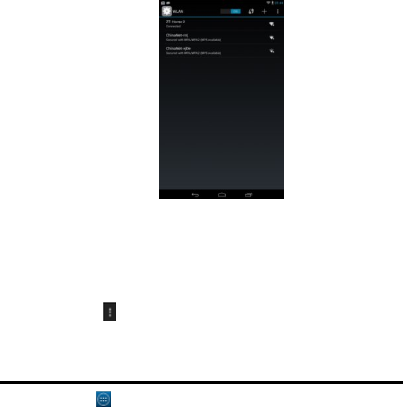
NOTE: To connect to a secured WLAN network, you must provide the
security key. If you do not have the security key, contact the person who
manages your WLAN network or the router manufacturer.
NOTE: To start a new search for available WLAN networks, on the
WLAN screen, tap → Scan
Connecting to the Internet using mobile broadband
1. Tap Settings→ WIRELESS & NETWORKS→ WLAN, then
touch WLAN to disable it.
2. The phone automatically searches for the carrier signal and
connects to the network. When the phone is connected to a mobile
broadband network, the network type appears in the status bar.
NOTE: On the LTE/HSPA+ models, if both WLAN and mobile
broadband networks are available, the phone gives priority to WLAN
connection.

Safety Information
The following list shows how to maintain your phone, together with
precautions to take.
Keep your phone and its accessories out of the reach of pets.
Do not allow children to use your phone. If children use the
device, make sure that they use the phone properly.
Maintain your phone in dry conditions and keep it within
normal operating temperatures.
Do not use or store your phone in dusty or dirty areas.
Do not attempt to disassemble your phone.
Do not drop or cause severe impact to your phone.
Do not use chemical products, cleaning solvents or
detergents to clean your phone.
If your phone does not work properly, contact your dealer
immediately.
Use only authorized batteries, battery chargers and
accessories. Any malfunction or damage caused by the use of
unauthorized batteries, battery chargers and accessories will void the
limited product warranty.
CAUTION: We do not assume any responsibility for the failure to
comply with the guidelines described above or for inappropriate use of the
Smartphone. We reserve the right to make changes to any of the contents
of this manual without notice. The contents of this manual may differ from
the actual content displayed on the Smartphone. In which case the latter
should prevail.
FCC RF Exposure Information and Statement
The SAR limit of USA (FCC) is 1.6 W/kg averaged over one gram of tissue.
Device types: VP5001I (FCC ID:2AFK7-VP5001I) has also been tested against
this SAR limit. The highest SAR value reported under this standard during product
certification for use at the ear is 0.260W/kg and when properly worn on the body
is 0.718W/kg. This device was tested for typical body-worn operations with the back
of the handset kept 1.0 cm from the body. To maintain compliance with FCC
RF exposure requirements, use accessories that maintain a 1.0 cm separation distance
between the user's body and the back of the handset. The use of belt
clips, holsters and similar accessories should not contain metallic components in its
assembly. The use of accessories that do not satisfy these requirements
may not comply with FCC RF exposure requirements, and should be avoided.
Body-worn Operation
This device was tested for typical body-worn operations. To comply with RF exposure
requirements, a minimum separation distance of 1.0 cm must be maintained between
the user’s body and the handset, including the antenna. Third-party belt-clips, holsters,
and similar accessories used by this device should not contain any metallic
components. Body-worn accessories that do not meet these requirements may not
comply with RF exposure requirements and should be avoided. Use only the supplied
or an approved antenna.
This device complies with part 15 of the FCC rules. Operation is subject to the
following two conditions: (1) this device may not cause harmful interference,
and (2) this device must accept any interference received, including interference that
may cause undesired operation.
NOTE: The manufacturer is not responsible for any radio or TV interference caused
by unauthorized modifications to this equipment. Such modifications
could void the user’s authority to operate the equipment. NOTE: This equipment has
been tested and found to comply with the limits for a Class B digital device, pursuant
to part 15 of the FCC Rules. These limits are designed to provide reasonable
protection against harmful interference in a residential installation. This equipment
generates uses and can radiate radio frequency energy and, if not installed and used in
accordance with the instructions, may cause harmful interference to radio
communications. However, there is no guarantee that interference will not occur in a
particular installation. If this equipment does cause harmful interference to radio or
television reception, which can be determined by turning the equipment off and on,
the user is encouraged to try to correct the interference by one or more of the
following measures:
- Reorient or relocate the receiving antenna.
- Increase the separation between the equipment and receiver.
-Connect the equipment into an outlet on a circuit different from that to which the
receiver is connected.
-Consult the dealer or an experienced radio/TV technician for help.